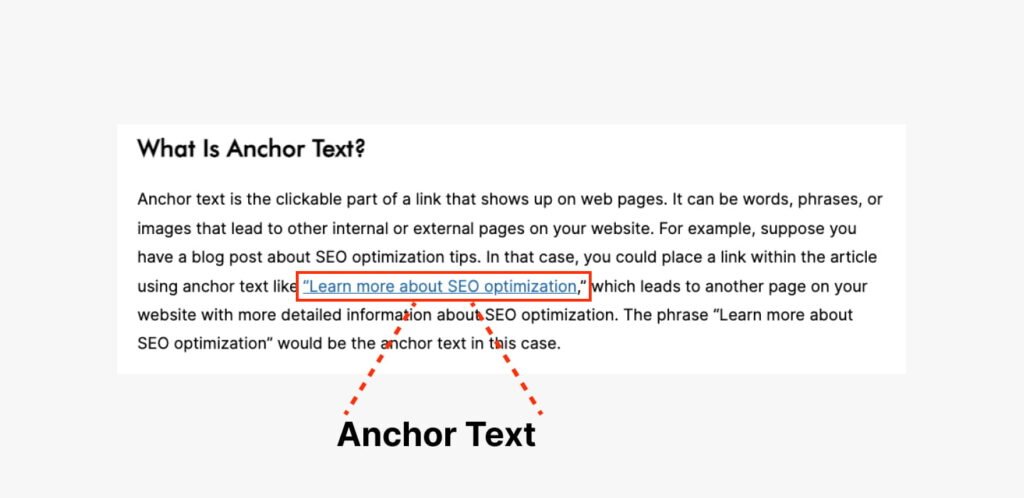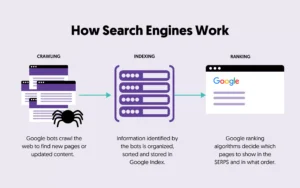Anchor text plays a key role in SEO. It can boost your site’s visibility.
Understanding anchor text is essential for improving your website’s search engine ranking. Anchor text is the clickable text in a hyperlink. It provides both users and search engines with context about the linked page. Effective use of anchor text can enhance user experience and help search engines understand your content better.
This guide will explore the importance of anchor text, different types, and best practices. By mastering anchor text, you can make your site more search-friendly and engaging for visitors. Let’s dive into the world of anchor text and see how it can benefit your SEO strategy.

Credit: www.link-assistant.com
Importance Of Anchor Text
Anchor text plays a crucial role in the world of SEO. It is the clickable text in a hyperlink, guiding users and search engines through your website. Effective use of anchor text can greatly enhance your site’s visibility and user experience.
Role In Seo
Anchor text helps search engines understand the context of a linked page. Relevant keywords in anchor text signal to search engines what the linked page is about. This improves the search engine ranking of both the source and target pages. Using varied and relevant anchor text can enhance the overall SEO strategy.
Impact On User Experience
Good anchor text improves user navigation on a website. It provides clear information about what to expect on the linked page. This enhances the user’s browsing experience and keeps them engaged. Users are more likely to click on links with descriptive anchor text. It guides them to relevant content efficiently.

Credit: moz.com
Types Of Anchor Text
Understanding the different types of anchor text can improve your SEO strategy. Anchor text is the clickable text in a hyperlink. It tells search engines and users what the linked page is about.
Exact Match
Exact match anchor text uses the exact keyword for which the linked page wants to rank. For example, if the keyword is “best running shoes”, the anchor text is also “best running shoes”. This type is powerful but should be used carefully. Overuse can lead to penalties from search engines.
Partial Match
Partial match anchor text includes the keyword along with other words. For instance, “find the best running shoes” or “top-rated running shoes”. This type is more flexible and appears natural in content. It balances keyword relevance and readability.
Branded
Branded anchor text uses the brand name as the clickable text. For example, “Nike” or “Adidas”. This type helps build brand recognition. It is also safe from over-optimization penalties. Use branded anchors to maintain a natural link profile.
Choosing The Right Anchor Text
Choosing the right anchor text is crucial for effective SEO. Anchor text, the clickable words in a hyperlink, informs both users and search engines about the linked page’s content. To achieve the best results, focus on relevance and keyword strategy.
Relevance
Ensure your anchor text is relevant to the content it links to. This helps search engines understand the context and improves user experience. For example, if linking to an article about digital marketing tips, use related phrases like effective digital marketing strategies or top digital marketing techniques.
Avoid generic phrases like click here or read more. These offer no context and can confuse both users and search engines.
Keyword Strategy
Incorporate your target keywords naturally into the anchor text. This practice signals to search engines the relevance of the linked content. For instance, if your keyword is SEO best practices, use it directly in the anchor text.
Be mindful of keyword stuffing. Overusing exact match keywords can lead to penalties. Instead, vary your anchor text with partial matches and related phrases. This creates a more natural and user-friendly experience.
Here’s a simple table to illustrate different types of anchor text:
| Type | Example |
|---|---|
| Exact Match | SEO best practices |
| Partial Match | best practices for SEO |
| Related Phrase | top SEO techniques |
| Generic | click here |
Mixing these types ensures a balanced approach and better results.

Credit: fatjoe.com
Anchor Text Best Practices
Anchor text plays a crucial role in SEO. Using it correctly can enhance your website’s visibility. Here, we explore some best practices for anchor text. These tips help you avoid common mistakes and maintain a natural flow.
Avoid Over-optimization
Over-optimization can hurt your SEO efforts. Using the same keyword-rich anchor text repeatedly can signal spam to search engines. Diversify your anchor texts. Use variations and synonyms. This practice makes your content look natural and trustworthy.
Also, avoid using exact match keywords too often. It can trigger penalties. Instead, blend your keywords with generic phrases. This approach helps distribute link equity effectively.
Maintain Natural Flow
Anchor texts should fit seamlessly into your content. They should sound like a natural part of the sentence. Avoid forcing keywords into your text. This can disrupt the reading flow.
Use descriptive anchor texts. They give users a clear idea of what to expect. This improves user experience and keeps readers engaged. Remember, natural and relevant anchor texts are key to effective SEO.
Analyzing Competitor Anchor Text
Understanding how your competitors use anchor text can improve your SEO strategy. Analyzing their techniques gives you an edge. It helps you see what works. And what doesn’t. This process can reveal patterns. It can also uncover opportunities you might have missed.
Tools And Techniques
Several tools can help analyze competitor anchor text. Ahrefs and SEMrush are popular options. These tools provide detailed reports. They show the types of anchor texts used. And where they are placed. You can also use Moz’s Link Explorer. It offers insights into anchor text distribution.
Each tool has unique features. They offer different levels of detail. Choose one that suits your needs. Consider your budget as well. Free options are available too. Google Search Console is one. It provides basic information. Use it to get started.
Extracting Insights
Once you have the data, look for patterns. Notice which anchor texts are most common. See if they use exact match keywords. Or if they prefer branded text. Check the context around the anchor texts. This can give clues about their strategy.
Compare their tactics with yours. Identify gaps in your strategy. Look for opportunities to improve. Adjust your anchor text approach. Aim to match or surpass your competitors. Focus on relevance and variety. This will help improve your rankings.
Common Mistakes To Avoid
Anchor text is crucial for SEO. But, many people make mistakes. Avoid these common errors to improve your site’s ranking.
Keyword Stuffing
Keyword stuffing is a big no-no. It happens when you use the same keyword too much. This can make your content look spammy.
For example:
| Good | Bad |
|---|---|
| Learn about SEO tips | Best SEO tips, SEO tips, SEO tips |
Search engines dislike this practice. They may lower your site’s ranking. Use keywords naturally. It helps your content read better.
Irrelevant Links
Using irrelevant links is another common mistake. These are links that don’t match the content.
For example:
| Good | Bad |
|---|---|
| Learn SEO strategies | Click here for SEO tips |
This confuses your readers. It also hurts your SEO. Always ensure your links are relevant. This keeps readers happy and engaged.
These are just a few mistakes to avoid. Follow these tips to improve your anchor text strategy.
Tools For Managing Anchor Text
Managing anchor text is crucial for SEO strategy. It helps search engines understand your content. The right tools can simplify this task. Below are some top options for managing anchor text efficiently.
Seo Software
SEO software like Ahrefs and SEMrush offers detailed anchor text analysis. They provide insights into your anchor text distribution. You can see which texts are overused or underused. These tools help you optimize your anchor text for better rankings.
Another popular tool is Moz. It shows you how your anchor text is performing. You can track changes and see their impact on your SEO. Moz also offers recommendations for improvement. This ensures your anchor text is always on point.
Analytics Platforms
Google Analytics is a powerful tool for tracking anchor text. It shows you which anchor texts are driving traffic. You can see the performance of each link. This helps you make data-driven decisions.
Another useful platform is Piwik. It offers similar features to Google Analytics. Piwik lets you customize reports. You can focus on specific anchor texts. This makes it easier to spot trends and adjust your strategy.
Case Studies And Success Stories
Anchor text plays a crucial role in SEO. It helps search engines understand what the linked page is about. Learning from real-world examples and success stories can be very insightful. These case studies demonstrate how effective anchor text strategy can lead to significant results.
Real-world Examples
Consider the case of a small e-commerce website. They wanted to improve their rankings for specific product categories. They decided to use descriptive anchor text for internal links. For example, instead of using “click here,” they used “best running shoes” or “affordable kitchen gadgets.” This change led to a noticeable increase in their search engine rankings. Their traffic and sales improved within a few months.
Another example is a travel blog focusing on destination guides. They started using location-specific anchor text like “things to do in Paris” and “best hotels in Rome.” This precise anchor text helped them rank higher for those search queries. Their organic traffic grew, and their blog became more popular among travelers.
Lessons Learned
From these examples, several lessons can be learned. First, always use descriptive anchor text. It should clearly describe the linked content. This helps both users and search engines understand the relevance of the link.
Second, avoid using generic terms like “click here” or “read more.” These phrases do not provide context. They do not help with SEO. Instead, use specific keywords related to the linked page.
Third, consistency is key. Make sure to use a consistent anchor text strategy across your website. This creates a clear and organized linking structure. It improves user experience and boosts your search engine rankings.
Finally, monitor your results. Keep track of how changes in anchor text affect your traffic and rankings. Use this data to refine your strategy over time.
Frequently Asked Questions
What Is Anchor Text?
Anchor text is the clickable text in a hyperlink. It often appears as blue underlined text. Anchor text helps search engines understand the linked page’s content.
Why Is Anchor Text Important?
Anchor text is important for SEO. It provides context to search engines about the linked page. Relevant anchor text can improve your search engine ranking.
How To Choose Good Anchor Text?
Choose anchor text that is relevant to the linked page. Use keywords naturally. Avoid generic phrases like “click here. ” Be descriptive and concise.
Can Anchor Text Affect Seo?
Yes, anchor text affects SEO. Properly optimized anchor text helps search engines understand content. Misleading or spammy anchor text can harm rankings.
Conclusion
Effective anchor text improves your website’s SEO. Choose words that match content. Keep it relevant and natural. Avoid keyword stuffing. Diverse anchor text is key. This helps search engines understand context. Boosts user experience too. Start implementing these tips today.
Enhance your site’s visibility and engagement. Happy optimizing!

Sofia Grant is a business efficiency expert with over a decade of experience in digital strategy and affiliate marketing. She helps entrepreneurs scale through automation, smart tools, and data-driven growth tactics. At TaskVive, Sofia focuses on turning complex systems into simple, actionable insights that drive real results.

























